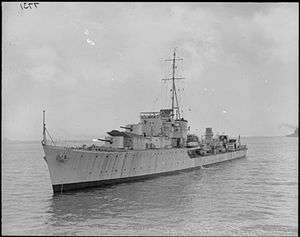HMS Oribi (G66)
 | |
| History | |
|---|---|
| Name: | HMS Oribi |
| Ordered: | 3 September 1939 |
| Builder: | Fairfield Shipbuilding and Engineering Company, Govan, Scotland |
| Laid down: | 15 January 1940 |
| Launched: | 14 January 1941 |
| Commissioned: | 5 July 1941 |
| Decommissioned: | 1 January 1946 |
| Honours and awards: | Norway 1941, Malta convoys 1941, North Africa 1942, Arctic convoys 1942-44, Atlantic 1943-44, Normandy 1944 |
| Fate: | Sold to Turkey[1] |
| Name: | Gayret |
| Acquired: | 1946 |
| Fate: | Scrapped 1965 |
| General characteristics | |
| Class and type: | O-class destroyer |
| Displacement: | 1,540 long tons (1,560 t) |
| Length: | 345 ft (105 m) o/a |
| Beam: | 35 ft (11 m) |
| Draught: | 13 ft 6 in (4.11 m) |
| Propulsion: |
|
| Speed: | 37 knots (43 mph; 69 km/h) |
| Range: | 3,850 nmi (7,130 km) at 20 kn (23 mph; 37 km/h) |
| Complement: | 175 |
| Armament: |
|
HMS Oribi (G66) was an O-class destroyer of the Royal Navy. Following the style of her sister ships she was named with a word beginning with O. Originally she was to have been christened HMS Observer, but Because her building was sponsored by the South African government she was christened HMS Oribi, after the oribi, a South African antelope. In 1942, after a successful warship week, the ship was "adopted" by Havant, Hampshire.
Second World War service
Oribi was one of the destroyers that supported Operation Archery, the November 1941 commando raid on Norway, by shelling the islands and attacking German shipping in the sheltered anchorage. She also assisted to bring Norwegian nationals home after the raid to escape the German occupation.
She saw extensive action during the Arctic and North Atlantic convoys of the Second World War. These included Convoy ONS 5 in May 1943, regarded as the turning point of the Battle of the Atlantic. At 03:00 on 6 May 1943 U-125 was located by radar in thick fog, rammed by HMS Oribi and disabled, she was unable to dive. At 03:54 the U-boat was sighted by the Flower-class corvettes Snowflake and Sunflower, and as Snowflake manoeuvred to attack, closing to 100 yards, the crew of U-125, realising their indefensible position, scuttled the boat. The captain of Snowflake signalled the Senior Officer Escort, Lieutenant Commander Robert Sherwood, proposing to pick them up, and received the response: "Not approved to pick up survivors." Snowflake and Sunflower thereupon resumed their positions around the convoy, while the crew of U-125 died in the Atlantic over the next few hours.[2]
Postwar service
Oribi was transferred to the Turkish Navy in 1946 and renamed Gayret, to replace a previous ship of that name requisitioned by the Royal Navy during the Second World War and lost during hostilities. She received the new pennant number D15 and was used as a headquarters ship.[3]
Notes
- ↑ Ex-British O class destroyers at battleships-cruisers.co.uk
- ↑ wikipedia
- ↑ Blackman, Raymond V B, Jane's Fighting Ships 1963-4, Sampson Low, Marston & Co. Ltd, London, p249
References
- Colledge, J. J.; Warlow, Ben (2006) [1969]. Ships of the Royal Navy: The Complete Record of all Fighting Ships of the Royal Navy (Rev. ed.). London: Chatham Publishing. ISBN 978-1-86176-281-8. OCLC 67375475.
- Connell, G. G. (1982). Arctic Destroyers: The 17th Flotilla. London: William Kimber. ISBN 0-7183-0428-4.
- English, John (2001). Obdurate to Daring: British Fleet Destroyers 1941–45. Windsor, UK: World Ship Society. ISBN 978-0-9560769-0-8.
- Friedman, Norman (2006). British Destroyers & Frigates: The Second World War and After. Annapolis, Maryland: Naval Institute Press. ISBN 1-86176-137-6.
- Lenton, H. T. (1998). British & Empire Warships of the Second World War. Annapolis, Maryland: Naval Institute Press. ISBN 1-55750-048-7.
- Raven, Alan; Roberts, John (1978). War Built Destroyers O to Z Classes. London: Bivouac Books. ISBN 0-85680-010-4.
- Rohwer, Jürgen (2005). Chronology of the War at Sea 1939-1945: The Naval History of World War Two (Third Revised ed.). Annapolis, Maryland: Naval Institute Press. ISBN 1-59114-119-2.
- Whitley, M. J. (1988). Destroyers of World War 2. Annapolis, Maryland: Naval Institute Press. ISBN 0-87021-326-1.
- Ian Kinloch Bryce ( 2005 )author = Shipmates and Mistresses.bye and large. publisher = The Memoir Club ISBN 1-84104-043-6